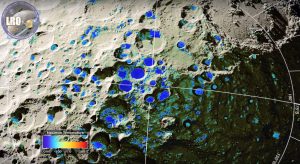Scientists Discover Signs of Frost on the Moon

In craters near the south pole of the moon, NASA’s Lunar Reconnaissance Orbiter found some bright areas and some very cold areas. In areas that are both bright and cold, water ice may be present on the surface as frost. Photo Credit: NASA’s Goddard Space Flight Center/Scientific Visualization Studio.
A group of scientists, including University of Hawai‘i at Mānoa researcher Paul Lucey, have found evidence of frost in craters near the south pole of the moon.
Using data from NASA’s Lunar Reconnaissance Orbiter (LRO), researchers analyzed data combining surface temperatures with information about how much light is reflected off the lunar surface using a laser-equipped instrument aboard the probe.
“We found that the coldest places near the moon’s south pole are also the brightest places—brighter than we would expect from soil alone—and that might indicate the presence of surface frost,” said Elizabeth Fisher, the lead author of the study, published in Icarus.
Fisher completed the data analysis while conducting research with Lucey at the UHM Hawai‘i Institute of Geophysics and Planetology after earning her undergraduate degree. She is now a graduate student at Brown University.
The icy deposits appear patchy and thin, and may be mixed in with the surface layer of soil, dust and small rocks on the moon, also known as regolith.
“We estimate that the ice detected would fill about one Olympic-sized swimming pool,” said Lucey.
The frost was found in deep lunar craters that are shielded from direct sunlight. Temperatures in these regions remains below minus 260 degrees Fahrenheit (minus 163 degrees Celsius). In these conditions, water ice can remain for millions or even billions of years.
Scientists suggested the presence of water ice in these permanently dark regions of the moon more than a half-century ago, but confirming that hypothesis was challenging.
“These findings demonstrate once again the value of studying the moon from orbit long-term,” said John Keller, the LRO project scientist at NASA’s Goddard Space Flight Center in Greenbelt, Maryland. “All of this work begins with comprehensive data sets made up of years’ worth of continuous measurements.”
The new findings strengthen the case that craters have trapped frost near the moon’s south pole. So far, researchers have turned up no signs near the north pole.
“What has always been intriguing about the moon is that we expect to find ice wherever the temperatures are cold enough for ice, but that’s not quite what we see,” said Matt Siegler, a researcher with the Planetary Science Institute in Dallas, Texas, and a co-author on the study.















